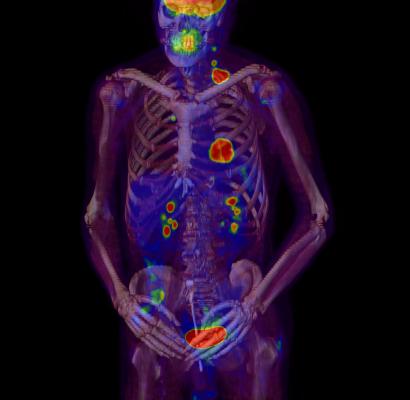
February 14, 2017 — The American Society for Radiation Oncology (ASTRO) recently published an updated clinical guideline that underscores the safety and effectiveness of palliative radiation therapy (RT) for treating painful bone metastases. Based on recent clinical trial data, the guideline recommends optimal RT dosing schedules for pain relief, including options for re-treatment. The guideline, “Palliative radiation therapy for bone metastases: Update of an ASTRO Evidence-Based Guideline,” is available as a free access article in Practical Radiation Oncology, ASTRO’s clinical practice journal.
When cancer cells spread through the body and invade a patient’s bones, these new lesions are known as bone metastases. Many different types of cancer can spread to the skeletal system, including breast, prostate, lung and rectal cancers, and bone metastases may occur months or even years after an original cancer diagnosis. Treatment of these malignancies aims to provide relief for symptoms, such as pain and spinal cord compression, and to suppress local disease.
Radiation therapy, also known as radiotherapy, is a safe and effective option to relieve symptoms associated with bone metastases. The updated guideline maintains the four previously recommended dosing schedules for external RT to treat previously unirradiated tumors: a single 8 Gy fraction of RT; 20 Gy administered in five fractions; 24 Gy in six fractions; or 30 Gy in 10 fractions. Research indicates that patients experience similar pain relief and toxicity rates with each of the fractionation options. Although clinical trials have cited higher retreatment rates for patients who received single-fraction RT, the convenience of this option may make it the optimal choice for patients with limited life expectancy. A recent analysis of clinical trial data published in JAMA Oncology recommended that “a single 8-Gy radiotherapy dose for bone metastases should be offered to all patients, even those with poor survival.”
Greater adoption of the single-fraction approach — which requires only one visit — also may reduce the disparity between the number of patients who would benefit from this therapy and the markedly small number who actually receive it. Surveys of palliative care professionals indicate that the vast majority consider RT an important and effective component of hospice care but do not actually refer many of their patients for the therapy. In one study, for example, 88 percent of hospice professionals said that painful bone metastases merited referral for palliative RT, but only 3 percent of hospice patients nationwide actually received the treatment. Barriers including cost, transportation and length of treatment were cited as key reasons for underutilization.
“Decades of research and many clinical trials have established that radiation therapy provides safe, effective and quick pain relief for patients suffering from bone metastases,” said Stephen Lutz, M.D., FASTRO, chair of the task force that developed the guideline update and a radiation oncologist at Blanchard Valley Regional Health Center in Findlay, Ohio. “Moreover, this relief can be achieved in as little as a single fraction, which alleviates the additional burdens of time, travel and cost for the patient.”
In addition to primary treatment, the guideline also addresses retreatment of bone metastases. It recommends that reirradiation should be considered if patients experience recurrent or persistent pain more than a month following external-beam radiation therapy (EBRT) to treat peripheral bone metastases or spine lesions. Research demonstrates moderate effectiveness for reirradiation; a 2014 systematic review and meta-analysis found an overall pain response rate of 58 percent.
The guideline also considers the role of advanced RT techniques, such as stereotactic body radiation therapy (SBRT), in primary treatment and retreatment of painful bone metastases. SBRT uses sophisticated imaging techniques to deliver a highly targeted, escalated dose of radiation to the tumor and to limit damage to the surrounding tissue. This precise targeting is particularly important for tumor sites near multiple surrounding organs, such as the lung or prostate, or complex sites, such as the neural system.
While emerging evidence points to the potential of SBRT to treat spinal metastases, research in this area is limited compared with the data supporting EBRT. Accordingly, the guideline recommends that the use of advanced RT techniques for primary treatment or retreatment of spinal lesions should be considered only in clinical trial or registry settings. It also recommends that physicians consult the current ASTRO white paper on SBRT to inform their treatment decisions.
The guideline was based on a systematic literature review of studies published from December 2009, the last date that was searched for the original 2011 guideline, through January 2015. A total of 414 abstracts were retrieved from PubMed, and the 56 articles that met inclusion criteria (including 20 randomized controlled trials, 32 nonrandomized prospective studies and four meta-analyses or pooled analyses) were abstracted into evidence tables and evaluated by an eight-member expert panel of radiation oncologists and topic experts in metastatic disease. The clinical practice statement was approved by ASTRO’s Board of Directors following a period of public comment.
Read the article “High Intensity Focused Ultrasound Offers New Tumor Treatment Options”
For more information: www.practicalradonc.org


 December 11, 2025
December 11, 2025 









